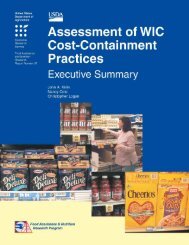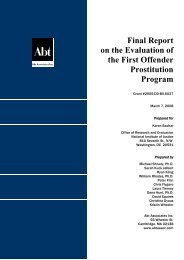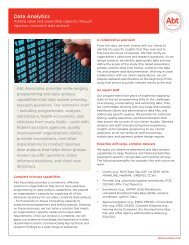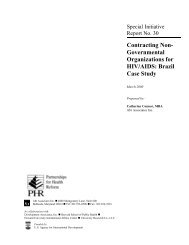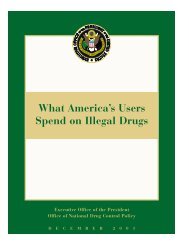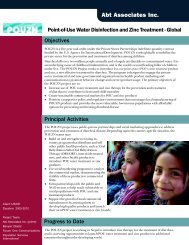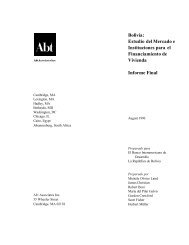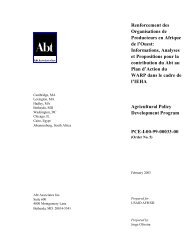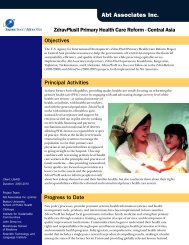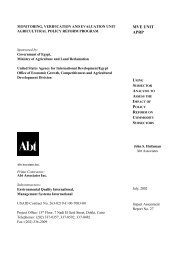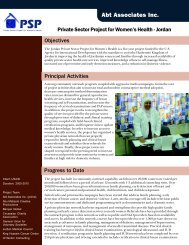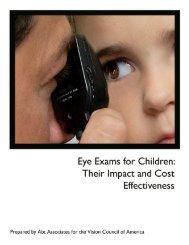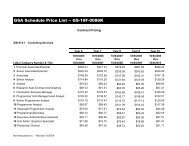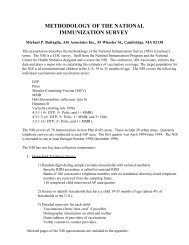Fertilizer Production And Marketing In Egypt ... - Abt Associates
Fertilizer Production And Marketing In Egypt ... - Abt Associates
Fertilizer Production And Marketing In Egypt ... - Abt Associates
Create successful ePaper yourself
Turn your PDF publications into a flip-book with our unique Google optimized e-Paper software.
4. MARKET PERFORMANCE<br />
4.1 Prices<br />
During the APRP period, the market for chemical fertilizer was relatively stable, with prices showing<br />
very little as indicated in Table 9.<br />
PBDAC<br />
Cooperatives<br />
Private Traders<br />
Table 9: Prices of Urea by Supplier, 1997 and 2001<br />
(LE per 50 kg)<br />
Supplier 1997 2001 Difference (%)<br />
27.0<br />
27.9<br />
29.0<br />
17<br />
27.3<br />
27.2<br />
28.6<br />
1.1<br />
-2.5<br />
-1.4<br />
Source: Morsy Aly Fawzy et al. The Impact of APRP at the Farm Level, MVE/APRP Impact Assessment Report<br />
No.28, July 2002.<br />
The price of urea supplied by PBDAC showed little increase while the price of urea supplied by<br />
cooperatives and private traders showed some decline, indicating more efficient operation of the last<br />
two suppliers in the marketing of chemical fertilizer.<br />
The nominal Protection Coefficient (NPC) shows the extent of protection of local production Table 10<br />
shows the domestic price of Abou Qir urea and the world price of Urea in the Black Sea market c.i.f.<br />
Alexandria. The NPC is defined as the ratio of domestic f.o.b. price to the border or c.i.f. price for a<br />
domestically produced commodity. It is clear from the table that the change in the domestic price during<br />
the period under study did not exceed 11.1 percent, while the world price decreased by 59.4 percent<br />
from 1995 to 1999, but, increased by 238.5 percent from 1999 to 2001. This relative stability of<br />
domestic prices and the highly fluctuating world prices severely affected the NPC. The domestic price<br />
was higher than import parity for the years 1997, 1998, and 1999, but was much lower during the<br />
remaining years under study. Therefore, there was implicit taxation in some years and implicit subsidy<br />
in the other years. Again, this indicates the necessity of reviewing the policy of the GOE in keeping the<br />
ex-factory prices for chemical fertilizer relatively stable. The prices of the majority of farm outputs (with<br />
the exception of sugar cane) have been left to market forces for determination, and they have been free<br />
to move upward with world prices. Allowing chemical fertilizer prices to fluctuate with crop prices<br />
would stabilize aggregate farm income in most cases better than holding one of the two prices relatively<br />
fixed while freeing the other to move in response to market forces.<br />
4.2 APRP Contributions<br />
Even though changes in policy toward chemical fertilizer were not a major thrust of APRP, the<br />
project did play a role in reducing the role of the public sector and subsidized companies and<br />
increasing the role of private traders. These steps included:<br />
• The design and implementation of policy benchmarks aimed at increasing the role of the<br />
private sector in production and in marketing, in order to increase competition and improve<br />
performance.



